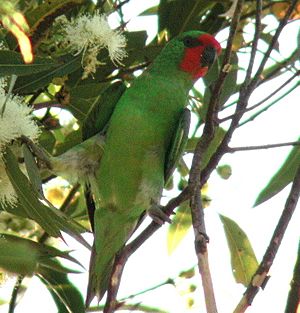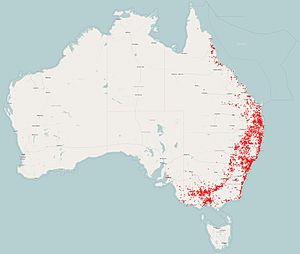Little lorikeet facts for kids
The little lorikeet (Parvipsitta pusilla) is a tiny, colorful parrot found only in Australia. It belongs to the parrot family called Psittaculidae. This small bird is mostly green with a bright red face. It loves living in warm, wet forests and dry woodlands.
Quick facts for kids Little lorikeet |
|
|---|---|
 |
|
| Conservation status | |
| Scientific classification | |
 |
|
| The Distribution of the little lorikeet, Data from The Atlas of Living Australia | |
| Synonyms | |
|
Psittacus pusillus |
Contents
About the Little Lorikeet's Name
The little lorikeet got its first scientific name from a scientist named George Shaw in 1790. He called it Psittacus pusillus. The word pusilla comes from Latin and means "small."
People also call this bird by other names. Some common names are tiny lorikeet and red-faced lorikeet. It was also once known by an old local Indigenous term, gerryang.
What Does the Little Lorikeet Look Like?
The little lorikeet is about 15 centimeters (6 inches) long. Both male and female birds look very similar. However, the female might have slightly duller colors.
Their head, face, and throat are bright red. The back of their neck and shoulders have a bronze color. The rest of their body is green. Their belly is a lighter, yellowish-green shade. Adult birds have a black beak and golden eyes. Young lorikeets have a lighter orange face. Their eyes and beak are brown.
Where Do Little Lorikeets Live?
Little lorikeets live in eastern and southern Australia. You can find them from Cairns in Queensland, south through New South Wales. They live from the western slopes of the Great Dividing Range all the way to the coast. They are also found in most of Victoria and southeastern South Australia. You might even see them in Tasmania, but they are not very common there.
These birds prefer to live in forests. They especially like areas where there are lots of flowering or fruit-bearing plants.
Little Lorikeet Behavior
Little lorikeets are very social birds. They often fly together in groups. Sometimes, they even join flocks of other lorikeet types. These can include rainbow, musk, and purple-crowned lorikeets.
What Do Little Lorikeets Eat?
Little lorikeets mainly eat nectar and pollen from flowers. They find these tasty treats in the open tops of woodland trees. Some of their favorite trees include Eucalyptus, Angophora, and Melaleuca species.
They also enjoy eating from native grasstrees (Xanthorrhoea species). Sometimes, they will eat fruit, like native mistletoe. They also like the loquat (Eriobotrya japonica), which was brought to Australia from other places. Occasionally, they might visit fruit orchards to find food.
Little Lorikeet Reproduction
Little lorikeets usually have their babies between May and December. In the northern parts of Australia, the breeding season starts in May. In the south, it begins around August.
They build their nests in hollows inside trees. A female lorikeet will lay about 3 to 5 eggs. These eggs are dull white and roundish, measuring about 20 by 16 millimeters. The eggs hatch after about three weeks.
Keeping Little Lorikeets as Pets
Little lorikeets were first sent to Europe in 1877. However, you rarely see them outside of Australia today. Even in their home country, they are not common pets. These birds are known for being quite difficult to keep in captivity.
See also
 In Spanish: Lori carirrojo para niños
In Spanish: Lori carirrojo para niños


